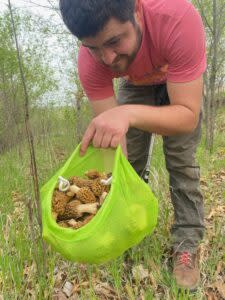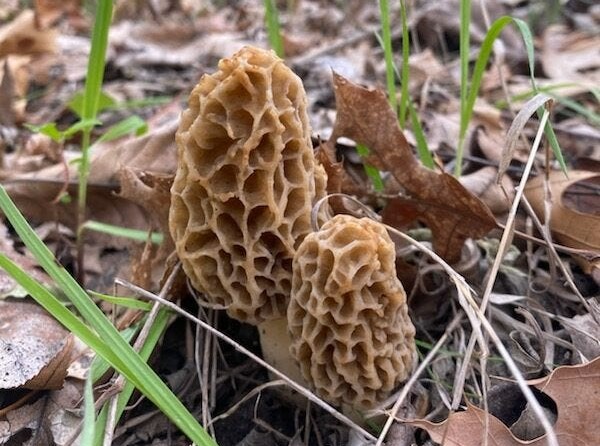Morel mushrooms, waiting to be plucked. (Photo by Sara Williams)


Perhaps more than anything else, I’m proudest to have fallen into a life with a person who, every springtime, becomes tragically serious about looking for morel mushrooms. (Also serious about tracking tornadoes on her phone, TV shows about a place called Skinwalker Ranch, and a little roulette about once a year.)
This life together might not exist without morels.
Sara and I first started spending time together after shifts in search of them, sometimes by flashlight late at night and always in places that we were not supposed to be. The first morel we ever found together, in the last stand of trees a Wells Fargo campus hadn’t yet claimed, rests on a bookshelf that holds some sentimental CDs and an inherited mini-bottle liquor collection.
They shrink down to next to nothing, and are hard as rocks.
Over the years, we’ve started to bring our friends along with us, trying to show them the joy and absurdity of parking on the shoulder of the highway and heading out with the rest of the walking-stick-and-Walmart-bag crowd. So far it’s been a success: Sara’s best friend now carries a meat thermometer out with her while she’s walking, stabbing the ground and checking the soil temperatures wherever she happens to find them.
Irony is that Sara and I don’t eat them. Not anymore. She got sick on them once, all mixed up with lots of keg beer. I never did like the taste. So many hours spent each spring, and we wind up giving them to friends or folks who can no longer get out and find the things themselves.
You’d be surprised how many older Iowans over the years have wandered into the suburban grocery stores where we’ve worked and asked to buy morel mushrooms. We’d always take their number, say we’d try to help them out if we could, much to the worry of our bosses, who probably have great paranoid dreams of liability lawsuits.
Once we met up with a woman in a mall parking lot and gave her morels. She nearly cried, promised us that they would make her Easter dinner, and her mother’s year. She said that her mother was in her 90s.
Those particular morels marked time well spent. Most do.
Superstition and outright lies abound in searching for morels. Lucky talismans and T-shirts are both encouraged. The deer and lone star ticks don’t mind, either way. Sara always sings a song or repeats a secret morel mantra. It’s tradition now that once I find my first mushroom, I pantomime a laugh like Nelson Muntz from “The Simpsons.”
“HA-ha!”
If you come across someone else out hunting on public land, it’s a requisite to lie and say you haven’t found any, especially if you have. Know that they are doing the same. The one family rule we have was taught to me by my grandfather, and that’s to wear a hat.


Morel lore: You only bring out the bag after you find a second mushroom. (Photo by Sara Williams)
First one found always goes into the hat as a sort of offering. Carry that around until you find another. It’s then, and only then, that you can bring out a bag. Mesh is best, for the belief is that as you continue to walk, you will spread the spores of the morels wherever you go. Like most everything about morels, the line between ritual and fact blurs, becomes unimportant. And yet, we follow.
I can’t be alone in acknowledging that it’s getting harder for me to keep track of seasons, to keep track of time at all. The new climate binary seems to be: drought, then cold. Sometimes it’s 70 in March. The next week it snows. Even the weather here is burned out. Polarized.
But I can always tell when it is morel season. It rains and sometimes hails. There’s mayapples growing on the forest floor and the wild Virginia bluebells are approached by a loud and lumbering bumble bee. Then a hummingbird shows up from a winter spent somewhere south, probably beach side, now half-starved for Iowa County sugar water.
We’ve seen more cars parked with ours out at county parks this year than any year before. A retail work schedule allows for time off during the week, and still, they’re out there in the early afternoon, hiking the trails and “swinging stick.”


Avery Gregurich with a haul of morels. (Photo by Sara Williams)
Earlier this week, a man sauntered up to us in the woods, intent on learning us about morels. There must be something about the two of us, some part of our appearance or walk or demeanor that encourages strangers to try to teach us about things that we already know. As if two bleeding hearts in bicycle caps couldn’t possibly also be interested and quite capable of finding and identifying morel mushrooms. We drive our hand-me-down pickup around this county for just this reason, trying to pass as locals in town most known for one of Iowa’s worst chemical spills in recent decades.
“Any luck?” he says.
Sara: “Not really. How about you?”
“A little … What you’re looking for are these,” he says.
He comes up to me and holds out a gray morel that could have fit on the end of a pencil.
“This is a gray one,” he says, pinching the stem.
“And this is a yellow one,” he says, raising up his other hand.
It’s a verpa, or false morel, which as the name implies, isn’t considered a morel at all, at least not in our house and most of the various morel hunting websites Sara traffics, like the Iowa Morel Report and The Great Morel.
I just don’t have it in my Midwestern heart to tell him he’s wrong, that without correct preparation, it’s mildly poisonous to even the most hardened wild mushroom eater.
“Looks like a lot of work,” I say instead, keeping a gray morel tucked inside my palm, pushed into my back pocket.
I thanked him for showing me his haul and he headed down off the hill and to his van, sure he’d been a help to some wayward strays out for the first time, spurred on by social media or something. We stayed out a while longer, finding a few along the path he’d left by. I worried about not telling him about the verpa.
But he didn’t ask, and as he could rightly tell, we’re not from here and therefore not to be trusted.
Clearly.
We arrived into this morel season with a tornado, and I’m writing this tonight beneath the threat of another. We’ve raced home to shut the windows and get the clothes down off the line. This evening’s total: twelve gray and sort-of-sunburnt morel mushrooms, five still-traveling ticks, and a dead robin.
Thanks to the rain, the season will last a few more days, maybe another week or so.
Who knows? Everybody claims to be an expert on the whole thing. I know for certain that none of them will get it exactly right, but we’re sure to be out there, until the warm, bitter end.
This column was originally published by Avery Gregurich’s blog, The Five and Dime. It is republished here through the Iowa Writers’ Collaborative.
Editor’s note: Please consider subscribing to the collaborative and the authors’ blogs to support their work.
The post Lying, trespassing and hat wearing are essential parts of morel hunting appeared first on Iowa Capital Dispatch.
